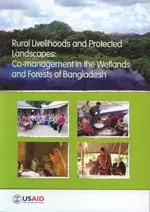Error message

One of the poorest and most densely populated nations in the world, Bangladesh is also arguably the most vulnerable to the negative impacts of climate change. Increased salinity of soils in coastal regions as well as increased incidence and severity of cyclones and other natural disasters lend credence to the argument that the impacts of climate change are already here. Thus, Bangladesh must struggle in its efforts toward poverty alleviation and food security, and build a foundation of resilience to ensure gains made today can be sustained into the future. Increasingly, Bangladesh government officials and civil society recognize the importance of a healthy and integrated protected area system as a fundamental building block in its foundation of resilience. An integrated protected area system ensures that forests and wetlands are managed to conserve and sustain key environmental services. Based on the principles of co-management, government and communities are working together to ensure conservation of existing protected areas (PAs), to demonstrate the development benefits of conservation of protected areas, and to expand this network in size and complexity through the Nishorgo Network -- 'Recognizing the need to save/conserve the most productive ecosystems of the country, the Government of Bangladesh materialized its concern by establishing the Nishorgo Network comprising of forest and wetland Protected Areas'. This book is a contribution to strengthening co-management of Bangladesh's PA system. Papers in this volume are based on research funded as part of the Nishorgo Network's IPAC program. Research funds were allotted to government officers from various departments, as well as to one post-graduate student, to support site-specific research pertaining to issues of community-based conservation. It is expected that the research findings reported in this book will illuminate new directions for policy and implementation strategies for creating arrangements that meet the goals conservation while not hindering the livelihoods of local community members. Spending time to investigate the realities of local resource users in both wetland and forest environments will help in tailoring conservation programs to the site-specific variables of socio-natural environments. |
|
One of the poorest and most densely populated nations in the world, Bangladesh is also arguably the most vulnerable to the negative impacts of climate change. Increased salinity of soils in coastal regions as well as increased incidence and severity of cyclones and other natural disasters lend credence to the argument that the impacts of climate change are already here. Thus, Bangladesh must struggle in its efforts toward poverty alleviation and food security, and build a foundation of resilience to ensure gains made today can be sustained into the future. Increasingly, Bangladesh government officials and civil society recognize the importance of a healthy and integrated protected area system as a fundamental building block in its foundation of resilience. An integrated protected area system ensures that forests and wetlands are managed to conserve and sustain key environmental services. Based on the principles of co-management, government and communities are working together to ensure conservation of existing protected areas (PAs), to demonstrate the development benefits of conservation of protected areas, and to expand this network in size and complexity through the Nishorgo Network -- 'Recognizing the need to save/conserve the most productive ecosystems of the country, the Government of Bangladesh materialized its concern by establishing the Nishorgo Network comprising of forest and wetland Protected Areas'. This book is a contribution to strengthening co-management of Bangladesh's PA system. Papers in this volume are based on research funded as part of the Nishorgo Network's IPAC program. Research funds were allotted to government officers from various departments, as well as to one post-graduate student, to support site-specific research pertaining to issues of community-based conservation. It is expected that the research findings reported in this book will illuminate new directions for policy and implementation strategies for creating arrangements that meet the goals conservation while not hindering the livelihoods of local community members. Spending time to investigate the realities of local resource users in both wetland and forest environments will help in tailoring conservation programs to the site-specific variables of socio-natural environments. |
|




